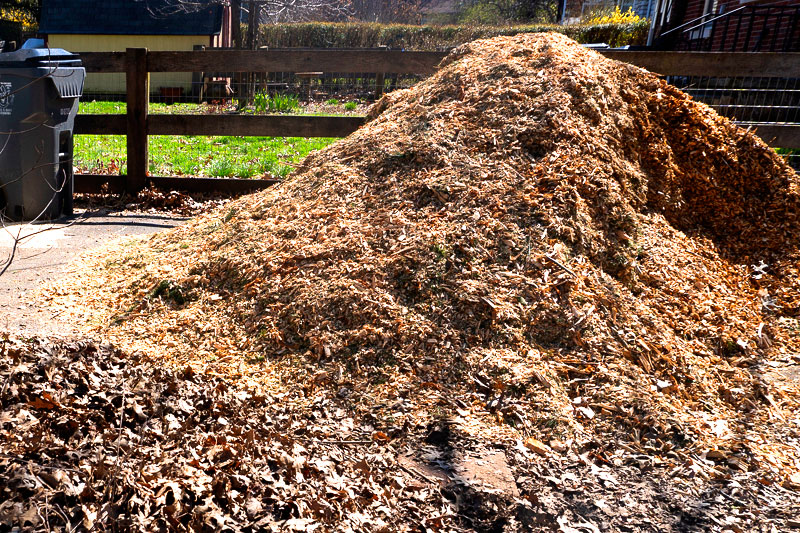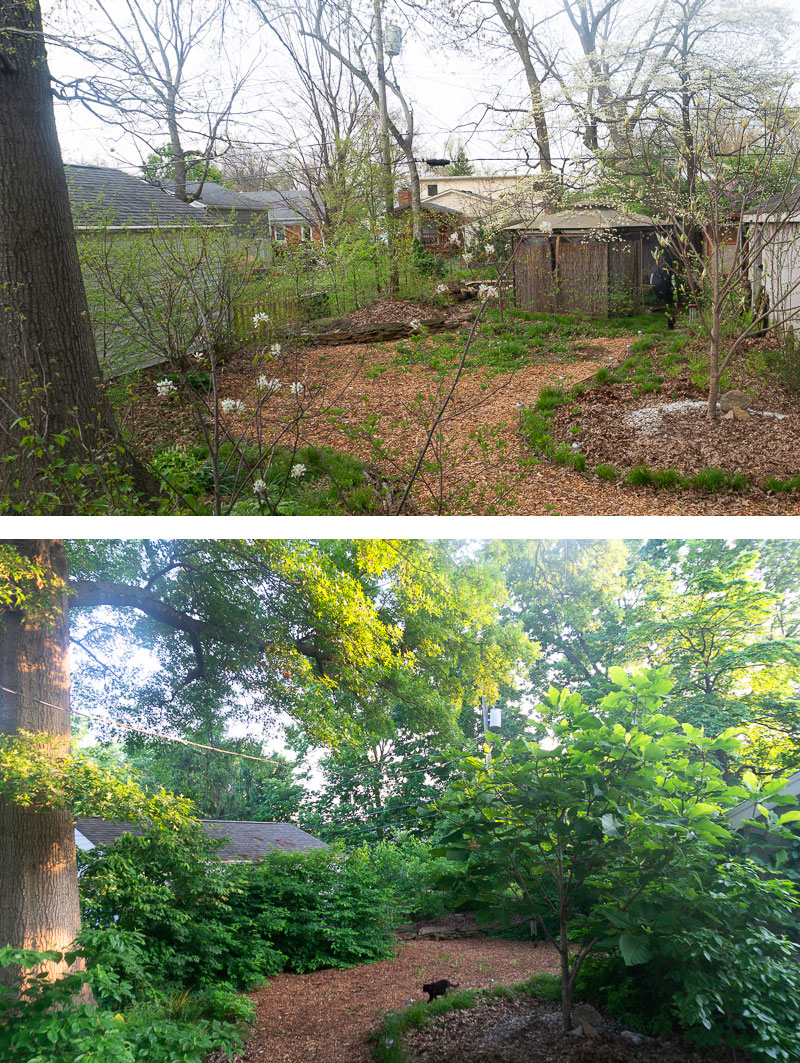
Altering an existing garden path has practical and symbolic meanings. Ultimately, a path directs people through a space. When considering a pathway makeover, ask yourself: Who will be there, and what is the destination? How will the path affect the space as a whole? How will the path interact with plants in the garden?
Before Altering the Path
A couple of years ago, I moved into a house with my partner, a landscaper who had been there for several years. We are both nature lovers in the city, and we make the most of a small space by planting native perennials for food and wildlife. The backyard’s garden pathway leads through a small native tree nursery to an annual vegetable bed, compost pile and firewood shed. The pathway material my partner originally used was red concrete pavers that were already on the property. These square stepping-stones add an element of order to the somewhat chaotic look of the natural space. They are also practical for keeping boots clean on the way to and from the compost and woodshed.
The Problems With the Path
The stepping-stone garden path functioned fine for the 6-foot-tall person who placed it. However, I am about six inches shorter, with a shorter and wider stride and a different pace of walking. Even if we wanted to keep the pavers and just space them closer for my stride (which varies anyway), the ferns and sedges that line the pathway get bigger each year and we don’t want to cut them back. Dogwood trees, serviceberry shrubs and spicebush are elbowing each other for light and threatening to close off any pathway.
Stepping into a path someone else created and trying to adapt yourself to feel comfortable there can be a metaphor for relationships—your relationship with the plants, with the space itself and with the other people using it. How much do you sacrifice to fit in with an established garden, or with another person’s logistics? How much do ask the other party to meet your needs? How much encroachment do you tolerate from robust shrubs, and what will you ask another person to compromise? What are your own boundaries?
The Process
Envisioning the path ahead is a necessary step. It took time to develop an idea that we agreed on. Noticing others’ garden paths that were roomy, cushioned, natural and minimalist provided inspiration. Sitting on the back porch, sipping tea on Sunday mornings, gazing into the yard, we both wanted to see a space that didn’t remind us of how much work awaited. Projects should be tucked away out of sight: That much we could agree on, and that affected our pathway decision.
Thinning out and reorganizing the tree nursery was the first step. The absence of lots of little plants gave a sense of spaciousness, another principle we agreed on. Then we could sense the flow, which really is what pathways are all about. My partner’s original design was more clear to see—rounded beds shaped by the presence of a large oak tree and a bigleaf magnolia.

Working with what was readily available, we outlined a new, wide and more defined path with garden hose, ignoring the existing stepping-stones and predicting how the plants would continue growing. When we lifted the stones out, we filled in their gaps with transplants from the open space (aka the new path). In early spring, we moved many small sedges that had popped up into the original pathway to define a thick border between the ferns and other shade-loving species and the open space. Violets, dandelions and plantain thrived as soon as the soil warmed up, so I harvested as much of them as I could, made teas from the flowers and cooked the greens for delicious meals. We planned to smother out the rest of the “weeds” with the mulch coming soon (although I admit it was hard for me to kill them because they are so nutritious and tasty). As an additional touch to define the borders of the beds and the wide path, we used fallen twigs and branches as rustic, low fences. Next, we requested that a local arborist deliver wood chips, and days later we had a mountain of mulch to move.
Why Wood-Chip Mulch?
If you compare your garden scheme with a natural ecosystem, what would it be? A grassland, a desert, a forest? Your answer provides a clue as to a pathway medium that suits your space. In an eastern forest ecosystem, perennial woody plants such as our pawpaws, hazelnuts, serviceberry and spicebush depends on soil made largely of rotting wood. It’s only natural that wood chips complements their needs. For a vegetable garden full of annuals, we’d probably choose a different medium.
Gardeners often worry about fresh wood chips tying up nitrogen. Soil microorganisms are slowly digesting the mulch, and these microbes need nitrogen to build their own populations. They might draw that from the soil and reduce available nitrogen that growing plants need. Adding compost to the garden beds before mulching around them is one recommended technique to balance the nitrogen competition.
Mulch in itself is a multipurpose garden amendment that suppresses weeds, reduces water loss, prevents erosion and adds much-needed carbon to soil. The fungal communities that wood chips host take soil fertility to another level. Chopped leaves are great for perennial beds in the fall, but they’ll disappear within a season or two. Wood chips, however, take two or three years to decompose. By then, we’ll probably have some new ideas of how we want to use the space, and it will be easy to evolve into the next pathway.
The End Result
The stepping-stones continue where the structures come back into the area’s design—the garage door on the right, the gazebo on the left—and lead on to the woodshed, near a sunny spot with a small vegetable garden. It seems appropriate to keep them around the human-built environment.
We bought nothing to make this landscape improvement, and probably only invested about two weekend’s worth of time into the labor. However, it took a couple of years to get around to doing it, and the work was done in little spurts over a couple of months. So far, even in heavy rains, we’ve not tracked mud or wood chips into the house (a boot brush helps too). The natural, woodsy space where birds forage, breezes waft through and sunlight filters in provides calm and encourages us that we can accomplish little projects together. Walking side by side onto springy, aromatic wood chips soothes our senses and enriches our little sanctuary in the city, with a little less pavement in the path ahead.




